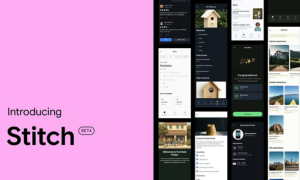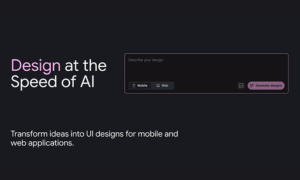
Jul 08 2025.
views 104By Hafsa Rizvi
You're sipping your morning coffee, sketching a rough app interface on a napkin, when suddenly you realize, what if this doodle could become a fully functional website in under two minutes? Welcome to 2025, where Google's latest brainchild, Stitch AI, is turning that wild dream into reality and making designers everywhere question if they've been doing things the hard way all along.

The Magic Wand Google Built
Announced at Google I/O 2025 with the kind of fanfare usually reserved for new iPhone launches, Stitch AI isn't just another tool in the overcrowded design software market, it's a fundamental shift in how we approach UI creation. Think of it as having a brilliant design intern who never sleeps, never gets tired, and can translate your wildest creative thoughts into pixel-perfect interfaces faster than you can say "responsive design."
At its core, Stitch operates on a beautifully simple premise: you describe what you want, and it builds it. Type "Create a mobile homepage for a recipe app with a bottom nav bar, profile card, and map view," and watch as Gemini AI transforms your words into a complete interface, complete with clean HTML and CSS that actually works. It's like having a conversation with your computer, except your computer actually listens and delivers exactly what you asked for.
But here's where it gets really interesting, Stitch doesn't just work with text. Upload a rough wireframe sketched on paper, a screenshot from your phone, or even that ambitious UI concept you drew on a whiteboard during last week's brainstorming session, and watch the AI work its magic. It understands visual language just as fluently as written instructions, bridging the gap between imagination and implementation in ways that feel almost supernatural.
The Gemini Advantage
Under the hood, Stitch is powered by Google's Gemini 2.5 models, offering users a choice between Flash and Pro modes that's reminiscent of choosing between a sports car and a luxury sedan, both will get you where you're going, but the experience is distinctly different.
Gemini Flash is the speed demon of the duo, perfect for rapid-fire ideation sessions where you need multiple design variations faster than a coffee break. Need to explore five different layouts for your landing page? Flash delivers them all before you've finished explaining your concept to a colleague.
Gemini Pro, on the other hand, is the perfectionist in the room. It takes a bit more time but delivers interfaces with the kind of attention to detail that would make seasoned designers nod in approval. The spacing is more refined, the colour choices more sophisticated, and the overall composition more polished, perfect for when you need something closer to production-ready.

Beyond Pretty Pictures
What sets Stitch apart from the legion of AI design tools flooding the market is its commitment to practicality. While many tools stop at generating beautiful mockups that look great in presentations but leave developers scratching their heads, Stitch bridges the notorious designer-developer divide by generating actual, usable code.
The HTML and CSS it produces isn't just functional, it's clean, semantic, and follows modern web standards. Developers can take Stitch's output and build upon it rather than starting from scratch, dramatically accelerating the journey from concept to deployment. It's like having a translator who speaks both designer and developer fluently, eliminating the communication gaps that have plagued digital product development for decades.
For teams working in established design systems, Stitch's Figma export feature is a game-changer. With a single click, your AI-generated interface becomes a proper Figma file, complete with layers, components, and all the organizational structure that design teams depend on. It's seamless integration at its finest, respecting existing workflows while supercharging them with AI capabilities.
The Creative Catalyst Effect
Perhaps the most fascinating aspect of Stitch isn't what it replaces, but what it enables. Designers report using it not as a replacement for their creative process, but as a catalyst that accelerates their exploration phase. Instead of spending hours pixel-pushing basic layouts, they can generate multiple variations instantly and focus their energy on refinement and strategic thinking.
Startups and solo founders are finding Stitch particularly transformative. Previously, the choice was often between expensive design agencies or DIY solutions that looked amateur. Stitch offers a third path – professional-quality design exploration accessible to anyone with ideas and internet access. It's democratizing good design in ways we haven't seen since the introduction of template-based website builders, but with infinitely more flexibility and sophistication.
The tool's conversational interface means iteration is as simple as saying "make the buttons more rounded" or "switch to a dark theme." This natural language approach eliminates the learning curve that traditionally separates great ideas from great execution, making design accessible to product managers, developers, and entrepreneurs who may lack formal design training but have clear vision about what they want to create.
The Free Lunch That Actually Exists
In a world where every software tool seems to come with an increasingly expensive subscription, Stitch's current pricing model feels almost too good to be true. Google is offering it completely free during its beta phase, with generous usage limits that allow for substantial exploration, around 350 Flash prompts and 50 Pro prompts monthly.
This isn't just a marketing strategy; it's a glimpse into Google's long-term vision of making AI-powered creativity tools as ubiquitous as search. By removing financial barriers during the crucial adoption phase, Google is positioning Stitch to become the default starting point for UI design exploration across the industry.
The implications extend beyond individual users to entire teams and organizations. Design agencies can use Stitch to accelerate their initial concepting phases, in-house teams can explore more variations in less time, and educational institutions can teach design principles without getting bogged down in tool-specific technicalities.
Redefining What's Possible
Stitch AI represents more than just another advancement in design tooling, it's a fundamental shift toward a future where creativity and technical implementation are no longer separate phases but integrated aspects of a single, fluid process. As we stand at the intersection of artificial intelligence and human creativity, tools like Stitch remind us that the future isn't about replacing human designers, but about amplifying their capabilities in ways we're only beginning to understand.
The question isn't whether AI will change design, it already has. The question is whether we're ready to embrace a world where our wildest creative ideas are just a conversation away from becoming reality.
0 Comments